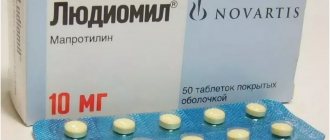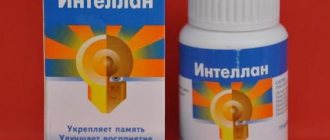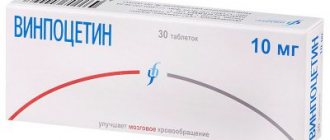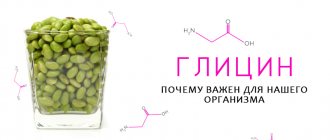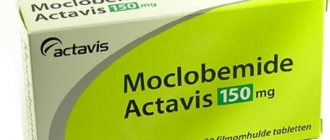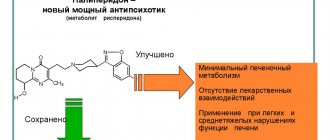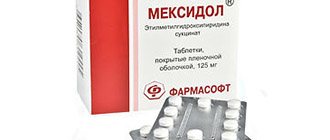Choosing a drug for the treatment of migraine is a difficult task, since much depends on concomitant pathologies, the nature of the migraine, the use of other drugs, and the individual characteristics of the patient. A migraine attack will end in any case, even without any treatment, but it may take many hours or even several days.
In order to accurately diagnose migraines, choose the right medication and get quality help for migraines, you should visit a neurologist.
Characteristics of the substance
Latin name of the substance : Sumatriptanum
Formula : C14H21N3O2S
Chemical name : Sumatriptan, 3-[2-(Dimethylamino)ethyl]-N-methylindole-5-methanesulfonamide. The preparations contain sumatriptan succinate.
Description : Powder of white or almost white color. Easily dissolves in water and saline.
Clinical and pharmacological group
- Serotonergic agent
- Selective 5-HT1 receptor agonist
- Drug with antimigraine activity
Action
Pharmacological action: anti-migraine.
Sumatriptan interacts with 5-HT1 receptors (does not affect the 5-HT2 - 5-HT7 receptor subtypes), mainly in the blood vessels of the brain (stimulation of 5-HT1 receptors leads to vasoconstriction). Selectively excites serotonin 5-HT1D receptors of brain vessels (dura mater of the basilar artery), inhibits activation of the trigeminal system and reduces the accumulation of specific stimulating protein in the nuclei of the trigeminal nerve, activates serotonergic antinociceptive mechanisms of the brain stem. Causes a narrowing of the vessel dilated during an attack and thereby stops the attack. Stops the development of a migraine attack without having a direct analgesic effect.
Rapidly absorbed when taken orally and after intranasal administration. Excreted by the kidneys and intestines.
The clinical effect is usually observed 30 minutes after oral administration of sumatriptan at a dose of 100 mg and 15 minutes after intranasal administration of 20 mg.
In 50–70% of cases, sumatriptan quickly relieves a migraine attack when taken orally in a dose of 25 to 100 mg. Eliminates nausea and photophobia associated with migraine attacks. The greatest effect is observed when used at the height of an attack. In approximately a third of cases, a relapse may develop within the next 24 hours, which necessitates repeated use.
Modern drugs for migraines
A modern headache medication is a highly effective remedy that helps eliminate the symptoms of diseases when the first attack occurs. The most modern and high-quality medicines are triptans. Drugs in this group relieve severe headaches and alleviate the suffering of the patient. Sometimes it is difficult to choose a medicine without knowing the properties of each type.
Main varieties
There are two main types. Triptans for headaches come in two types: the first type has improved pharmacological properties, the second type of triptans can be generic. Their action is aimed at activating the receptor that is responsible for a migraine attack. The name comes from the name of the main substance in the composition, which is sumatriptan. The products are available in the form of nasal spray, tablets and injections.
The fastest-acting way to relieve a headache is to administer an injection into the blood. The medicine begins to act within 5 minutes. Despite the type of triptan, the medicine should be taken at the first sign of illness. Timely treatment should be carried out in order to prevent the development of consequences.
The maximum dose of sumatriptan is 290 mg per day. Based on patient reviews, we can conclude that in some cases, medications effectively help eliminate the disease, but sometimes there are side effects. Among the side effects are the following:
- nausea;
- problems with the cardiovascular system;
- vomit.
The drug must be selected especially carefully; attention should be paid to second-generation migraine triptans. This is the second type of medicine, which is highly effective. This includes:
- Sumatriptan. Its action is aimed at reducing the diameter of the carotid artery, thereby eliminating the action of the trigeminal nerves. Do not take if angina or stroke is present.
- Taking Rizatriptan (you should read the instructions for use in advance) will have a positive effect on your overall well-being. Eliminates dizziness and nausea, effectively treats attacks. Contraindications include severe diseases of internal organs.
- Zolmitriptan will help reduce sensitivity to headaches.
- Eletriptan in tablet form will help eliminate an attack with an aura.
- Almotriptan will help with migraines and severe throbbing pain.
- Maxalt Forte is taken when the first sign of migraine appears. It is not a prophylactic drug.
The specific type of triptan is prescribed by your doctor. Much depends on the type of pain and the individual characteristics of the patient’s body.
Effect of medications
Triptans have a wide spectrum of action. To increase the effectiveness of the drugs, you should take into account the rules for taking the medicine. Using these tablets:
- blood vessels in the brain and membrane narrow;
- blood flow slows down;
- the necessary receptors are activated;
- pain and throbbing are relieved;
- the release of a specific protein from the trigeminal nerve is inhibited;
- inflammation is relieved;
- sensitivity decreases;
- the receptor is affected.
Headache spray is considered one of the fastest-acting remedies. Painkillers for migraines must be taken immediately. It will help quickly relieve pain. It must be administered through the nose; the medicine does not affect the functioning of the gastrointestinal tract.
Thanks to the use of Imigran, Dihydrergot, Sumatriptan, Metoclopramide and Ketorolac, it is possible to quickly and effectively eliminate migraine symptoms. These drugs are also produced in the country of Belarus. Produced by the Borisov Plant LLC organization.
Reception and dosage
It is recommended to start taking the drug at the first manifestations of a migraine attack.
is not used for the same migraine attack . In such cases, paracetamol, acetylsalicylic acid or NSAIDs can be used to relieve an attack.
However, sumatriptan can be used to relieve subsequent migraine attacks . If the patient feels improved after the first dose and then symptoms return, a second dose may be administered within the next 24 hours, provided that the interval between doses is at least 2 hours.
Pills
Taken orally, the tablet should be swallowed whole with water. Treatment should be started as early as possible when a migraine attack occurs.
The recommended dose is 50 mg, if necessary - 100 mg. The maximum daily dose is 300 mg.
Nasal spray
This dosage form is especially indicated for migraine attacks accompanied by nausea and vomiting in children over 12 years of age, as well as for achieving an immediate clinical effect. The spray is equally effective when used at any stage of a migraine attack.
Use intranasally. The recommended dose of the drug for adults is 20 mg per nasal passage; for children 12-18 years old - 10 mg per nasal passage.
Taking headache pills
The dosage depends on the individual characteristics of the body. Before taking, you should read the instructions. Among the main recommendations of doctors are:
- If pain occurs, you should first try to relieve the pain with a non-steroidal drug. For example, an analgesic or Nurofen forte.
- If the drug does not give a positive result, you should take a triptan.
- It is not advisable to take these medications at the time of an aura; it is unlikely that they will effectively fight migraines.
- During pregnancy, you should use the drug with caution. Before taking, be sure to consult your doctor.
If a person is often bothered by pain, it is important to monitor nutrition. Eliminate very harmful foods from the diet (carbonated drinks and fast foods). For migraines, it is not recommended to eat foods high in tyramine. Recommended products include:
- fish;
- white meat;
- cottage cheese;
- sour cream;
- fruits and vegetables;
- honey;
- natural juice.
It is necessary to include in your diet foods that contain riboflavin. This substance has a positive effect on the functioning of brain cells.
Drug dosage
It is forbidden to take the drug more than 2-3 times a month. Experts do not recommend preventing migraines with medications. The interval between taking tablets should not be less than 3 hours. If signs of migraine develop, take 1 tablet. It is advisable to drink plenty of water. Many people are wondering how dangerous a triptan is. Not everyone knows that if the dose is significantly increased, acute side effects will occur.
Therapists' recommendations
To forget about migraines for a long time, systematically taking the medicine is not enough. External factors that provoke pain should be taken into account. In order to minimize the risks of negative effects, doctors recommend:
- walk more often, walk more in the fresh air;
- do not spend a lot of time watching TV or computer;
- avoid nervous tension and stress;
- lead a healthy and active lifestyle;
- do not abuse alcohol;
- be regularly examined by a doctor;
- have a healthy sex life.
Frequent migraines may be a sign of a serious medical condition . To prevent their progression, you should consult a doctor when the first symptoms appear.
Contraindications
- Hypersensitivity,
- hemiplegic, basilar or ophthalmoplegic form of migraine,
- myocardial infarction (including history),
- uncontrolled arterial hypertension, coronary artery disease (including suspicion of it), angina pectoris, incl. Prinzmetal's angina, occlusive diseases of peripheral vessels,
- transient cerebrovascular accident (including a history), stroke (including a history),
- severe impairment of liver and/or kidney function,
- simultaneous use of sumatriptan with other serotonergic drugs (ergotamine, metisegride, triptans) and monoamine oxidase inhibitors.
Sumatriptan is not used to prevent migraine attacks!
Amigrenin®
Amigrenin® should be prescribed only if the diagnosis of migraine is beyond doubt.
Amigrenin® cannot be used for prophylactic purposes.
The drug Amigrenin® is contraindicated for use in hemiplegic, basilar and ophthalmoplegic forms of migraine. As with other drugs used to treat acute migraine attacks, other types of neurological pathology must be excluded before treating a headache attack in patients with previously undiagnosed migraine or in patients with atypical migraine. It should be noted that patients with migraine have an increased risk of developing certain cerebrovascular events (eg, stroke or transient ischemic attack).
Taking sumatriptan may be associated with transient symptoms such as pain and tightness in the chest, spreading to the neck; symptoms may be intense. If there is reason to believe that these symptoms are a manifestation of coronary artery disease, it is necessary to conduct an appropriate diagnostic examination. Amigrenin® should not be used in patients at risk of cardiovascular pathology without prior examination to exclude it (such patients include postmenopausal women, men over 40 years of age and patients with risk factors for the development of coronary artery disease). However, the examination does not always reveal heart disease in every patient. In very rare cases, serious cardiovascular adverse reactions may occur in patients without a history of cardiovascular disease.
Sumatriptan should be used with caution in patients with controlled hypertension, as transient increases in blood pressure and peripheral vascular resistance have been observed in a small number of patients.
There are rare reports from post-marketing surveillance of the development of serotonin syndrome (including mental disorders, autonomic lability and neuromuscular disorders) as a result of simultaneous use of SSRIs and sumatriptan. The development of serotonin syndrome has also been reported during concomitant use of triptans with SNRIs.
If a patient is indicated for simultaneous use of SSRIs and/or SNRIs, the patient's condition should be carefully monitored.
Concomitant use of any triptan (5-HT1 agonist) with sumatriptan is not recommended.
Amigrenin® should be used with caution in patients in whom the absorption, metabolism or elimination of sumatriptan may be significantly altered (for example, patients with impaired renal or hepatic function).
Amigrenin® should be used with caution in patients with a history of seizures or other risk factors for lowering the seizure threshold.
In patients with known hypersensitivity to sulfonamides, taking sumatriptan may cause allergic reactions that range from skin manifestations of hypersensitivity to anaphylaxis. Data on cross-sensitivity are limited, but caution should be exercised when using Amigrenin® in such patients.
Overuse of medications intended to treat migraine attacks is associated with increased headaches in sensitive patients (drug overuse headache). In this case, the possibility of discontinuing the drug should be considered.
Do not exceed the recommended dose of Amigrenin®.
Restrictions
For diseases
with caution for epilepsy and a history of seizures, controlled arterial hypertension, and in the presence of risk factors for the cardiovascular system.
Age
For people under 18 and over 65 years , safety and effectiveness have not been established. The nasal spray is approved for use from 12 years of age.
Pregnancy and lactation
During pregnancy , it is possible only if the expected benefit to the mother outweighs the potential risk to the fetus (insufficient safety studies). Breastfeeding should be avoided for 24 hours after taking sumatriptan, as the substance is absorbed into breast milk.
Effect on psychomotor skills
Drivers should exercise caution , as well as during work that requires increased attention and quick reaction. With migraine, as well as during therapy with sumatriptan, drowsiness may develop
Sumatriptan
The drug should be prescribed only if the diagnosis of migraine is beyond doubt.
The drug is contraindicated for use in hemiplegic, basilar and ophthalmoplegic forms of migraine.
Before starting treatment, it is necessary to exclude types of potentially dangerous neurological pathology (for example, stroke, transient ischemic attacks) in the case where the patient has atypical symptoms, or when the patient has not been diagnosed with a condition requiring the use of sumatriptan.
After taking the drug, transient symptoms may occur, including pain and tightness in the chest, which may be intense and extend to the neck area. If there is reason to believe that these symptoms are a manifestation of coronary artery disease, it is necessary to conduct an appropriate diagnostic examination.
The drug should not be used in patients with risk factors for the development of coronary artery disease, including heavy smokers or users of nicotine replacement therapy, without prior examination of the cardiovascular system.
Particular attention should be paid to postmenopausal women and men over 40 years of age with these risk factors. However, the examination does not always reveal heart disease in every patient. In very rare cases, serious adverse reactions from the cardiovascular system may occur in patients with no history of cardiovascular pathology.
The drug should be used with caution in patients with controlled arterial hypertension, since a transient increase in blood pressure and peripheral vascular resistance was observed in a small number of patients.
There are rare reports from post-marketing surveillance of the development of serotonin syndrome (including mental disorders, autonomic lability and neuromuscular disorders) as a result of simultaneous use of SSRIs and sumatriptan. The development of serotonin syndrome has also been reported during concomitant use of triptans with SNRIs.
In case of simultaneous use with drugs from the SSRI/SNRI group, the patient's condition should be carefully monitored.
The drug should be used with caution in patients with a history of seizures or other risk factors for lowering the seizure threshold.
In patients with known hypersensitivity to sulfonamides, taking the drug may cause allergic reactions that range from skin manifestations of hypersensitivity to anaphylaxis. Cross-sensitivity data are limited, but caution should be exercised before initiating sumatriptan in these patients.
Adverse reactions may occur more frequently during concomitant use of triptans and herbal preparations containing St. John's wort ( Hypericum perforatum
).
Overuse of medications intended to treat acute headaches is associated with increased headaches in sensitive patients (drug-overuse headache). In this case, the possibility of discontinuing the drug should be considered.
Side effect
Cardiovascular system and blood
Arterial hypotension or short-term increase in blood pressure, bradycardia or tachycardia; rarely - heart rhythm disturbances, myocardial infarction, Raynaud's syndrome.
Nervous system and sensory organs
Dizziness, weakness, drowsiness; rarely - convulsions (if there is a predisposition), decreased visual acuity, diplopia, scotoma.
Digestive system
Nausea, vomiting, dysphagia.
Allergic reactions
Skin rash, urticaria, itching; rarely - anaphylaxis.
Other
Muscle pain, tingling, feeling of heat, pressure in the chest, throat and other parts of the body.
For the intranasal form: burning, nosebleeds.
Interaction
Concomitant use is contraindicated:
- with ergotamine and ergotamine-containing drugs (prolonged vasospasm is possible, a 24-hour pause between doses is recommended);
- with monoamine oxidase inhibitors;
- with lithium salts (cases of the development of serotonin syndrome have been described);
- with drugs from the group of selective serotonin reuptake inhibitors;
- with other triptans (risk of additive hyperstimulation of serotonin receptors).
There was no interaction of sumatriptan with propranolol, flunarizine, pizotifen, or ethyl alcohol.
